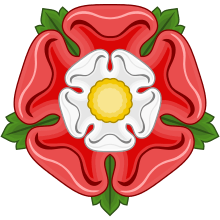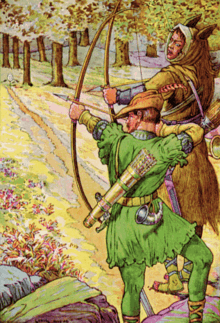National symbols of England

| Culture of England |
|---|
 |
| History |
| People |
| Languages |
| Traditions |
|
Mythology and folklore
|
| Cuisine |
|
Festivals
|
| Religion |
| Art |
| Literature |
|
Music and performing arts
|
|
Media
|
|
Monuments
|
|
|
The national symbols of England are flags, icons or cultural expressions that are emblematic, representative or otherwise characteristic of England or English culture. As a rule, these national symbols are cultural icons that have emerged from English folklore and tradition, meaning few have any official status. However, most if not all maintain recognition at a national or international level, and some, such as the Royal Arms of England, have been codified in heraldry, and are established, official and recognised symbols of England.
Flags
 |
The national flag of England, known as St. George's Cross, has been England's national flag since the 13th century. Originally the flag was used by the maritime state the Republic of Genoa. The English monarch paid a tribute to the Doge of Genoa from 1190 onwards, so that English ships could fly the flag as a means of protection when entering the Mediterranean. A red cross acted as a symbol for many Crusaders in the 12th and 13th centuries. It became associated with Saint George, along with countries and cities, which claimed him as their patron saint and used his cross as a banner.[1] Since 1606 the St George's Cross has formed part of the design of the Union Flag, a Pan-British flag designed by King James I.[2][2] |
 |
The Royal Banner of England[3] (also known as the Banner of the Royal Arms,[4] the Banner of the King) is the English banner of arms that features the Royal Arms of England. This Royal Banner differs from England's national flag, St George's Cross, in that it does not represent any particular area or land, but rather symbolises the sovereignty vested in the rulers thereof.[5] |
Heraldry
.svg.png) |
The Royal Arms of England[6] is a coat of arms symbolising England and the English monarchs.[7] Designed in the High Middle Ages, the Royal Arms was subject to significant alteration as the territory, politics and rule of the Kingdom of England shifted throughout the Middle Ages. However, the enduring blazon, or technical description, is "Gules three lions passant guardant in pale Or armed and langued Azure",[5][8] meaning three horizontally positioned identical gold lions facing the observer, with blue tongues and claws, on a deep red background.
Although officially subsumed into the heraldry of the British Royal Family in 1707, the historic Royal Arms featuring three lions continues to represent England on several coins of the pound sterling, forms the basis of several emblems of English national sports teams (such as the England national football team),[9][10] and endures as one of the most recognisable national symbols of England.[7] |
 |
The Tudor rose, which takes its name from the Tudor dynasty, was adopted as a national emblem of England around the time of the Wars of the Roses as a symbol of peace.[11] It is a syncretic symbol in that it merged the white rose of the Yorkists and the red rose of the Lancastrians—cadet branches of the Plantagenets who went to war over control of the royal house. It is also known as the Rose of England.[12] |
.svg.png) |
St Edward's Crown was one of the English Crown Jewels and remains one of the senior Crown Jewels of the United Kingdom, often being used as the coronation crown. Since 1952, two-dimensional representations of the crown have been used in coats of arms, badges, and various other insignia to indicate the authority of the monarch throughout the Commonwealth realms. |
Flora and fauna
 |
The Barbary Lion is a national animal of England. Lion was the nickname of England's medieval warrior rulers with a reputation for bravery, such as Richard I of England, known as Richard the Lionheart.[13] Lions are frequently depicted in English heraldry, either as a device on shields themselves, or as supporters. They also appear in sculpture, and sites of national importance, such as Trafalgar Square. The lion is used as a symbol of English sporting teams, such as the England national cricket team.[14] |
| |
The rose is the national flower of England. It is usually red,[14] and is used, for instance, in the emblems of the English Golf Union and England national rugby union team. |
| |
The oak is the national tree of England,[14] representing strength and endurance. The Royal Oak and Oak Apple Day commemorate the escape of King Charles II from the grasps of the parliamentarians after his father's execution; he hid in an oak tree to avoid detection before making it safely into exile. The Major Oak is an 800–1000 year old oak in Sherwood Forest, famed as the alleged principal hideout of Robin Hood. |
 |
The Eurasian Wren is the national bird of England and is considered to be the smallest bird in England. |
Food and drink
 |
Roast Beef and Yorkshire Pudding is a widely consumed part of English cuisine, and is symbolic of England.[14] It is considered to be the national dish of England. |
 |
Tea is symbolic of England.[14] In 2006, a government sponsored survey confirmed that a cup of tea constituted a national symbol of England.[15] It may also be considered to be symbolic of Britain rather than merely just England as it epitomises the British connection with Empire and India and is not specifically pre-Union of the Crowns or pre-Union of Parliaments. It is also drunk widely and equally in England, Scotland and Wales. |
Cider, perry, beer and ale could all be considered traditional English drinks. Mead would have been drunk by the Anglo-Saxons.
People
 |
Saint George is the patron saint of England.[1] |
 |
Alfred the Great was King of Wessex, becoming the dominant ruler in England.[16] |
 |
Robin Hood is a heroic outlaw in English folklore. |
See also
| Wikimedia Commons has media related to Symbols of England. |
- Symbols of the United Kingdom
References
- ↑ 1.0 1.1 "St. George – England's Patron Saint". Britannia.com. Retrieved 1 February 2009.
- ↑ 2.0 2.1 "United Kingdom – History of the Flag". FlagSpot.net. Retrieved 2009-09-05.
- ↑ Thompson 2001, p. 91.
- ↑ Fox-Davis 1909, p. 474
- ↑ 5.0 5.1 Fox-Davies 2008, p. 607.
- ↑ Jamieson 1998, pp. 14–15
- ↑ 7.0 7.1 Boutell 1859, p. 373: "The three golden lions upon a ground of red have certainly continued to be the royal and national arms of England."
- ↑ The First Foot Guards. "Coat of Arms of King George III". footguards.tripod.com. Retrieved 4 February 2010.
- ↑ Briggs167.
- ↑ Ingle, Sean (2002-07-18). "Why do England have three lions on their shirts?". The Guardian. UK. Retrieved 2010-09-15.
- ↑ "National flowers". Number10.gov.uk. 2003-01-13. Retrieved 2009-08-08.
- ↑ Smith, Jed (2005-06-03). "England's Rose – The Official History". Museum of Rugby, Twickenham. RugbyNetwork.net. Retrieved 2009-08-08.
- ↑ Garai, Jana (1973). The Book of Symbols. New York: Simon & Schuster. ISBN 0-671-21773-9.
- ↑ 14.0 14.1 14.2 14.3 14.4 "What images are associated with England?". projectbritain.com. Retrieved 2010-09-22.
- ↑ Gallagher 2006, p. 19.
- ↑ Yorke, B. A. E. (2001), "Alfred, king of Wessex (871-899)", in Michael Lapidge et al., The Blackwell Encyclopaedia of Anglo-Saxon England, Blackwell Publishing, pp. 27–28, ISBN 978-0-631-15565-2
Bibliography
- Boutell, Charles (1859). "The Art Journal London" 5. Virtue. pp. 373–376.
- Briggs, Geoffrey (1971). Civic and Corporate Heraldry: A Dictionary of Impersonal Arms of England, Wales and N. Ireland. London: Heraldry Today. ISBN 0-900455-21-7.
- Fox-Davies, Arthur Charles (2008) [1909]. A Complete Guide to Heraldry. READ.
- Gallagher, Michael (2006). The United Kingdom Today. London: Franklin Watts. ISBN 978-0-7496-6488-6.
- James, George Payne Rainsford (2009). The History of Chivalry. General Books LLC.
- Jamieson, Andrew Stewart (1998). Coats of Arms. Pitkin. ISBN 978-0-85372-870-2.
- Keightley, Thomas (1834). The crusaders; or, Scenes, events, and characters, from the times of the crusades 2 (3rd ed.). J. W. Parker.
- Thomson, D. Croal (2001). Fifty Years of Art, 1849–1899: Being Articles and Illustrations Selected from 'The Art Journal'. Adegi Graphics LLC.
External links
| ||||||||||||||||||